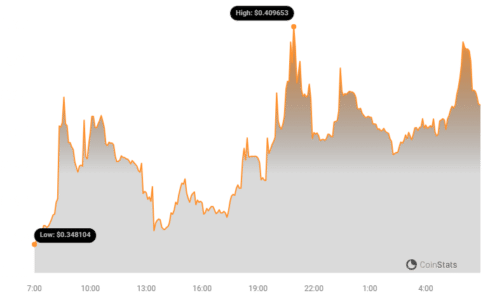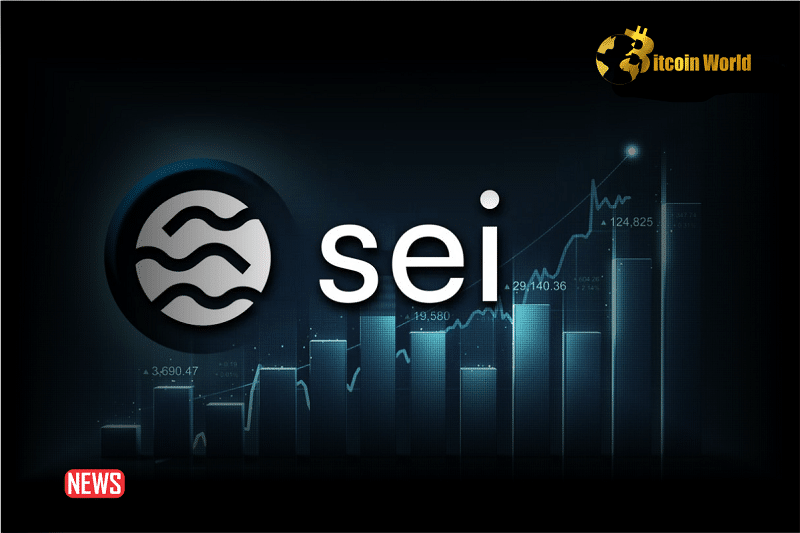Hold onto your hats, crypto enthusiasts! Sei Network (SEI), the blockchain built for blazing-fast trading, is making headlines with a jaw-dropping price surge. Over the last 48 hours, SEI has rocketed by more than 60%, hitting a new all-time peak of $0.365. This impressive leap propels Sei’s market capitalization to a solid $850 million, according to Coinstats. What’s fueling this explosive growth, and is it sustainable? Let’s dive in and break down the details.

Why is SEI Price Surging?
While Sei’s total value locked (TVL) currently sits at a modest $5 million, the resurgence of Solana (SOL) has played a significant role in reigniting investor interest in a new breed of Layer 1 blockchains. These networks, including SEI and SUI, are designed with parallel execution in mind, offering significantly faster transaction speeds and quicker finalization times. But what exactly does ‘parallel execution’ mean, and why is it such a game-changer?
Imagine a busy restaurant kitchen. Traditional blockchains like Bitcoin and Ethereum operate like a single-chef kitchen, processing orders one by one in a sequential manner. This can lead to bottlenecks and slower service, especially during peak hours. In contrast, blockchains like Sei, Solana, and Sui employ a ‘parallel execution’ model, similar to a kitchen with multiple chefs working simultaneously. This allows for many transactions to be processed at the same time, dramatically increasing speed and efficiency.
This difference in architecture is becoming increasingly crucial as the demand for faster and more scalable blockchain solutions grows. Let’s compare the traditional sequential approach with the parallel execution model:
| Feature | Sequential Execution (e.g., Bitcoin, Ethereum) | Parallel Execution (e.g., SEI, Solana, SUI) |
|---|---|---|
| Transaction Processing | One transaction at a time | Multiple transactions simultaneously |
| Transaction Speed | Slower, potential for congestion | Faster, higher throughput |
| Scalability | Lower scalability, struggles with high demand | Higher scalability, better equipped for mass adoption |
| Best Suited For | Applications where speed is not paramount | High-speed applications like trading, DeFi, gaming |
It’s no surprise then that SOL, SEI, and SUI have emerged as some of the top-performing Layer 1 tokens recently, reflecting a growing market appetite for blockchains that can handle demanding applications.
See Also: THORChain (RUNE) Down More Than 5% Within 24 Hours
SEI V2: A Game Changer?
Sei initially launched its mainnet beta in August, generating significant buzz. However, initial enthusiasm waned as early users expressed disappointment with the size of airdrops, which, for many, barely covered transaction fees. But Sei hasn’t stood still. The project has successfully regained momentum since announcing its V2 iteration in November. The key feature of V2? Ethereum compatibility.
This is a significant development. By embracing Ethereum Virtual Machine (EVM) compatibility, Sei aims to tap into the vast ecosystem of Ethereum developers, tools, and applications. As the project stated, “This allows Sei to get the best of Solana and Ethereum – a hyper optimized execution layer that benefits from the tooling and mindshare around the EVM.”
In essence, Sei V2 is attempting to create a powerful hybrid: the high-performance engine of a parallel execution blockchain combined with the rich and established ecosystem of Ethereum. This strategic move could unlock a wave of new possibilities for Sei, attracting developers and users seeking both speed and interoperability.
Looking Ahead: Is SEI a Good Investment?
The recent price surge and the promising V2 upgrade certainly paint a positive picture for Sei. However, it’s crucial to remember that the cryptocurrency market is inherently volatile, and past performance is not indicative of future results. While the technology behind Sei is compelling, and the move towards EVM compatibility is strategically sound, several factors will determine its long-term success:
- Ecosystem Growth: Attracting developers and building a thriving ecosystem of applications on Sei will be paramount. EVM compatibility is a major step in this direction, but active community building and developer support are essential.
- TVL Increase: While price appreciation is exciting, a substantial increase in TVL would indicate genuine user adoption and confidence in the Sei network.
- Competition: The Layer 1 blockchain space is crowded and competitive. Sei needs to differentiate itself and maintain its technological edge to stand out from the pack.
- Market Sentiment: Broader market trends and overall crypto sentiment will inevitably influence SEI’s price movements.
In Conclusion
Sei’s recent price surge is undoubtedly noteworthy, driven by renewed interest in high-performance Layer 1 blockchains and the anticipation surrounding its V2 upgrade. The project’s focus on parallel execution and EVM compatibility positions it as an interesting contender in the evolving blockchain landscape. However, as with any cryptocurrency investment, thorough research and an understanding of the inherent risks are crucial. Keep a close eye on Sei’s ecosystem development and TVL growth to gauge its long-term potential.
Disclaimer: The information provided is not trading advice. Bitcoinworld.co.in holds no liability for any investments made based on the information provided on this page. We strongly recommend independent research and/or consultation with a qualified professional before making any investment decisions.
Disclaimer: The information provided is not trading advice, Bitcoinworld.co.in holds no liability for any investments made based on the information provided on this page. We strongly recommend independent research and/or consultation with a qualified professional before making any investment decisions.


